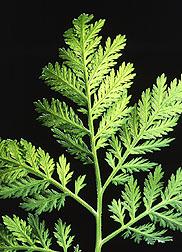| Read the magazine story to find out more. |
|
|
Rise in Carbon Dioxide May Boost Anti-Malarial Compound in Plant
By Sharon Durham
September 9, 2015
U.S. Department of Agriculture (USDA) scientists and their colleagues have found that recent and projected increases in atmospheric carbon dioxide have impacted, Artemisia annua, a common roadside weed in the United States. Globally, the weed is the source of artemesinin, a compound that is commonly used to treat malaria around the world. Malaria is a mosquito-borne disease that is widespread in tropical and subtropical regions, especially sub-Saharan Africa where it results in the death of half a million children each year.
Although there are extensive scientific efforts to determine the role of rising atmospheric carbon dioxide levels on plant growth, research on the affect carbon dioxide has on secondary plant compounds is limited. Yet, such compounds can play a significant role in human health.
Agricultural Research Service (ARS) plant physiologist Lewis Ziska at the Crop Systems and Global Change Research Laboratory in Beltsville, Md., was part of an international research team that used historical data and field experiments to determine that rising levels of carbon dioxide can increase artemesinin concentration in A. annua.
This research included an evaluation of herbarium samples from 236 locations in mainland China from over a 100 year timeframe (1905-2009) to quantify the relationship between recent increases in carbon dioxide and artemesinin concentration of A. annua during the 20th century. Field experiments were also conducted to grow and analyze wild and cultivated A. annua at projected mid-century (2060) concentrations of atmospheric carbon dioxide using free-air carbon dioxide enrichment methods. The research is reported in the journal Climatic Change.
According to Ziska, these data provide the first evidence that historic and projected increases in atmospheric carbon dioxide may be associated with global changes in artemesinin chemistry, potentially making a greater quantity of anti-malarial drug available for the same area of cultivation. However, the role of rising carbon dioxide on the production and/or concentration of other plant-based medicines will require further study.
ARS is USDA's principle intramural research agency.

